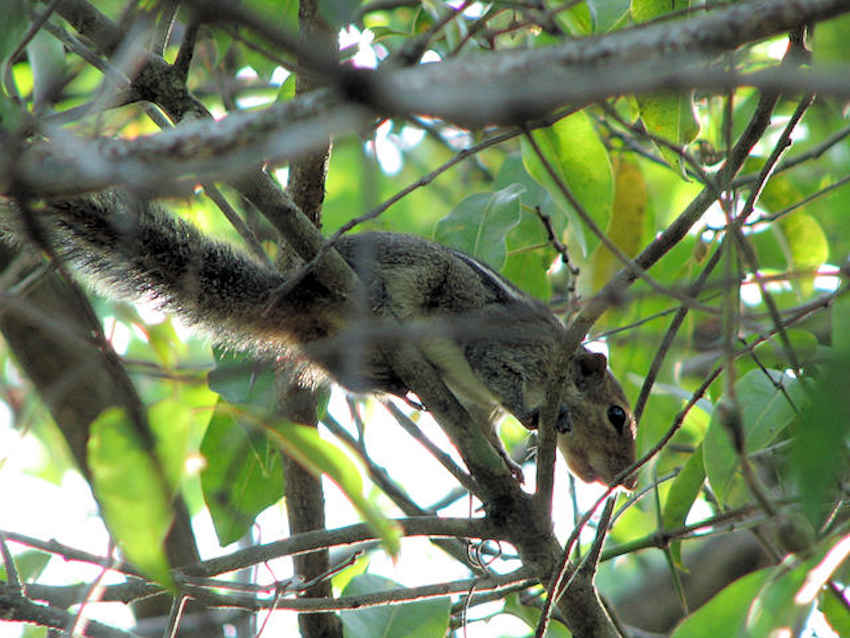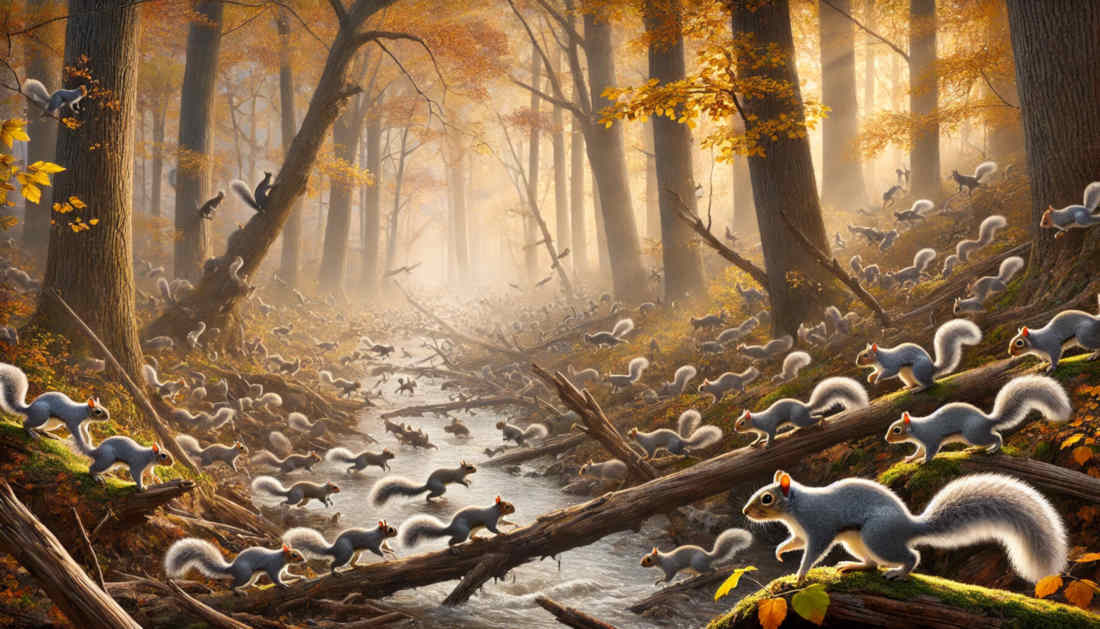The Great Squirrel Migrations

Squirrels would be so numerous in the forest canopy, the sky would darken with thier shadows.
When Squirrels Migrated - Yes, They Migrated.
Today, we think of squirrels as territorial creatures, staying within small patches of suburban yards or woodlands. They remain active year-round, even emerging on warm winter days to raid bird feeders. We assume they stay put. But for most of history-before the vast, interconnected forests of North America were destroyed and fragmented-squirrels undertook large, irregular migrations.
Centuries ago, in these vast and unbroken forests, massive squirrel migrations occurred every few years. Millions-possibly billions-of squirrels would sweep across the landscape, scouring the forest canopy for mast (seeds and nuts, primarily acorns). These migrations were so extensive that squirrels could travel for hundreds of miles without ever touching the ground, leaping from branch to branch. The sky would darken beneath their shadows as they moved in unison. They even swam across rivers and lakes in their relentless search for food.
Historical Records of Squirrel Migrations
Squirrel migrations must have occurred for thousands of years, but the first recorded accounts appear in the 1700s, as settlers began transforming forests into farmland.
1749
The earliest known report dates back to 1749, when a massive squirrel migration swept through Pennsylvania. Millions of squirrels moved in the same direction, consuming crops, grain, and seed stores as they passed through farmland and settlements. The event was such a nuisance that the Pennsylvania colony placed a bounty on them, leading to the official culling of over 640,000 squirrels (Farm Progress).
1803
Another remarkable migration was observed by Meriwether Lewis of the Lewis and Clark Expedition in 1803. While preparing for the journey westward, Lewis recorded large numbers of squirrels swimming across the Ohio River. He noted the migration on September 11th and even had his dog pluck some from the water for food. He observed the Ohio River squirrel crossing for an entire week (Lewis-Clark.org).
1811
In The Rambler in North America, Charles Joseph La Trobe provided a romanticized account of an 1811 squirrel migration, noting that, along with a picturesque flood and a comet, it made the year truly remarkable. Regarding the squirrels, he recounted:
"A countless multitude of squirrels, obeying some great and universal impulse, which none can know but the Spirit that gave them being, left their reckless and gambolling life, and their ancient places of retreat in the north, and were seen pressing forward by tens of thousands in a deep and sober phalanx to the South. No obstacles seemed to check this extraordinary and concerted movement: the word had been given them to go forth, and they obeyed it, though multitudes perished in the broad Ohio , which lay in their path." (La Trobe, 1835)
1822
In 1822, Indiana newspapers widely reported a massive "squirrel stampede". The number of squirrels was described as "beyond estimation," likely reaching the millions. This event occurred just a year after Indianapolis was founded, and as the squirrels moved through farmland and populated areas, they devoured everything in their path. (MeatEater).
Throughout the 1800's
Throughout the 1800s, reports of large-scale squirrel migrations surfaced every three to seven years, occurring somewhere across the country. Some accounts even described countless squirrels swimming across the Mississippi River for days on end. However, as forests were cleared and fragmented, and human populations expanded, these migrations grew smaller and less frequent. By the late 19th century, large-scale movements had nearly disappeared.
Why Did Squirrels Migrate?
While the massive migrations of the past remain largely undocumented in terms of scientific study, more recent-though much smaller-migrations have been observed. These events help explain why squirrels migrated in the first place.
One of the last major migrations occurred in 1968, following a particularly notable event in 1967. Squirrel researcher Vagn Flyger studied the phenomenon after reports surfaced of an unusual increase in squirrel roadkill stretching from Georgia to Vermont. He described the numbers as "spectacular" and noted that squirrels were appearing in regions where they were not typically found.
Through tagging, tracking, and dissecting migrating squirrels, Flyger determined that their movement-what he more accurately termed emigration-was driven by food availability. The year 1967 had been a mast year for oaks, producing a bumper crop of acorns and fueling a squirrel population boom. However, as is typical with oaks, the following year saw a sharp decline in acorn production. Faced with food shortages, the now-inflated squirrel population was forced to emigrate in search of sustenance (Flyger, 1968).
A much smaller migration was recorded in 1998 in Arkansas, but no large-scale migrations have been observed since.
Why Migrations (or Emigrations) No Longer Happen
The disappearance of squirrel migrations is largely due to the loss and fragmentation of forests. In pre-colonial times, an estimated 90% of the eastern United States was forested. Today, only 36% remains, much of it in fragmented patches, with just 6% consisting of intact, original forests. More than 75% of the region's woodlands have been lost, leaving the remaining forests disconnected and unable to support large-scale wildlife movements.
Today, with almost no continuous forests and a much smaller squirrel population, large-scale migrations no longer occur. Even if food shortages arise, there are no vast, unbroken landscapes for squirrels to move through. Modern highways and continuous urban sprawl create dangerous obstacles that prevent long-distance migrations.
While minor, localized movements may still occur, we will never again witness the breathtaking sight of millions of squirrels swimming across the Mississippi River for days on end, or the canopy so thick with squirrels that it blocks out the sun. The days of great squirrel migrations are over-another lost phenomenon of a once-unbroken wilderness.







